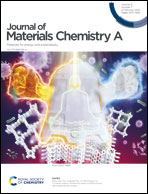Zn–O–C bonds for efficient electron/ion bridging in ZnSe/C composites boosting the sodium-ion storage†
Abstract
Metal-selenides are one of the next-generation anode materials for sodium-ion batteries (SIBs), but they suffer from sluggish charge/ion transport, huge volume expansion and aggregation of particles. Herein, ZnSe/C composites with Zn–O–C bonds and 3D hierarchical structure were successfully prepared. Precisely, ZnSe nanoparticles are tightly riveted in the 3D carbon matrix crosslinking by Zn–O–C bonds. The 3D carbon network improves structure stability by restricting volume expansion. More importantly, experimental results along with DFT calculations reveal that Zn–O–C bonds served as electron/charge bridge accelerate charge/ion transfer, indicating fast reaction kinetics. Electrochemically, ZnSe/C composites show an ultra-long lifetime of 1000 cycles at 5 A g−1 with a capacity of 281 mA h g−1. Furthermore, the electrochemical mechanism of conversion and alloy reactions is revealed by monitoring the phase evolutions and internal impedance changes during the charge–discharge process. Remarkably, the superior cycling life arising from 3D carbon matrix and Zn–O–C bonds demonstrates ZnSe/C composites as reversible and promising anode materials for SIBs. Valence bond bridging such as metal–O–C bonds will have broad prospects for enhancing structural stability and electrochemical properties.



 Please wait while we load your content...
Please wait while we load your content...